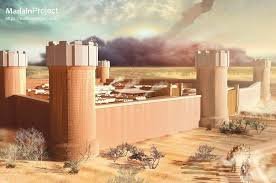The Legendary City Shrouded in Mystery of The Lost City of Ubar
The Lost City of Ubar, often referred to as the “Atlantis of the Sands,” is one of history’s most enigmatic archaeological mysteries. Nestled deep within the vast and unforgiving Rub’ al Khali Desert—the largest continuous sand desert in the world—Ubar was once a thriving hub of trade and wealth. Ancient texts and oral traditions describe it as a grand city of towering buildings, immense riches, and advanced engineering, only to vanish suddenly under the desert sands. Unlike other lost cities, Ubar’s disappearance was so complete that for centuries, scholars debated whether it was merely a myth or a real, buried metropolis waiting to be uncovered.
The Lost City of Ubar: Myths and Historical Accounts of Ubar
The earliest mentions of Ubar appear in Islamic, Arabian, and even Greek texts. The Quran references a place called “Iram of the Pillars,” a city of towering structures built by the ancient tribe of ‘Ad, who were punished for their arrogance and buried beneath a catastrophic sandstorm. Arabian folklore speaks of Ubar as a wealthy trading center that succumbed to divine wrath. Even the famed traveler Ibn Battuta wrote about hearing tales of a lost city swallowed by the desert. Western explorers like T.E. Lawrence (Lawrence of Arabia) became obsessed with finding Ubar, believing it held secrets of ancient Arabian civilization. These varied accounts fueled centuries of speculation, blending history with legend.
The Great Search for Ubar
For much of modern history, Ubar was considered a mere legend—until the late 20th century, when a combination of ancient texts, satellite imaging, and ground excavations brought it into reality. In the 1980s and 1990s, a team led by British explorer Sir Ranulph Fiennes and archaeologist Juris Zarins used NASA satellite data to identify ancient caravan routes converging at a single point in Oman’s Dhofar region. This led them to the ruins of a fortress-like structure buried beneath the dunes. The discovery confirmed that Ubar was not just a myth but a real, once-prosperous city that met a dramatic end.
The Astonishing Archaeological Findings
Excavations at the Ubar site revealed a fortified settlement with massive walls, towers, and evidence of advanced water management systems. Archaeologists uncovered pottery, incense burners, and trade goods from distant lands, proving Ubar’s role as a critical stop on the frankincense trade route. One of the most striking discoveries was a large sinkhole, suggesting the city’s collapse may have been due to the sudden caving in of limestone caverns beneath it—a possible scientific explanation for the legendary “swallowing by the sands.” The findings provided tangible proof that Ubar was a key player in ancient Arabian commerce before its catastrophic demise.

Ubar’s Role in the Frankincense Trade
Frankincense, one of the most valuable commodities of the ancient world, was traded extensively from southern Arabia to Mesopotamia, Egypt, and the Mediterranean. Ubar served as a crucial nexus for these caravans, where traders would rest, resupply, and negotiate deals. The city’s wealth came from controlling this lucrative trade, making it a target for envy and conflict. Some historians believe Ubar’s downfall was accelerated by shifting trade routes or raids from rival kingdoms, while others argue that environmental factors—such as dwindling water sources—sealed its fate.
Theories Behind Ubar’s Mysterious Disappearance
Several theories attempt to explain how such a powerful city could vanish so completely. The most widely accepted is the “sinkhole theory,” where underground water erosion caused the city to collapse into caverns beneath it. Another theory suggests that overuse of groundwater led to the city’s abandonment before the desert reclaimed it. Some even propose that a massive sandstorm, like those described in legends, buried Ubar in a single catastrophic event. Whatever the cause, the city’s sudden disappearance left behind only whispers in historical texts—until modern archaeology brought it back to light.
Ubar in Popular Culture and Modern Fascination
The allure of Ubar has captured imaginations beyond academia. It has been referenced in books, documentaries, and even video games as the ultimate lost city. Famed novelist Clive Cussler wrote The Treasure (1988), a fictionalized account of Ubar’s discovery. The city’s legend also inspired the Indiana Jones franchise, where it was depicted as a treasure-laden ruin. Today, Ubar remains a symbol of mystery, drawing adventurers and researchers eager to uncover more of its secrets.
Visiting the Ruins: What Remains The Lost City of Ubar Today
Though much of Ubar remains buried, the excavated ruins near Shisr, Oman, are accessible to intrepid travelers. The site features remnants of walls, towers, and the infamous sinkhole that may have doomed the city. Visitors can walk in the footsteps of ancient traders and imagine the once-bustling streets now silent under the desert sun. The surrounding Rub’ al Khali—known as the “Empty Quarter”—adds to the mystique, with its endless dunes hiding untold secrets. For those fascinated by lost civilizations, Ubar offers a rare glimpse into a world swallowed by time.
The Lost City of Ubar stands as a testament to human ambition and the relentless power of nature. Its rediscovery bridged myth and reality, proving that even the most legendary places may still lie hidden, waiting to be found. Whether seen as a cautionary tale or a historical marvel, Ubar continues to captivate as the legendary Atlantis of the Sands.
Go to main page


